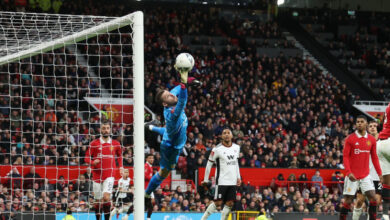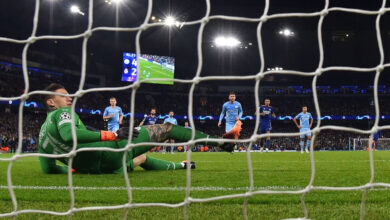
In today’s new series we are going to be looking at some of the greatest myths in goalkeeping and explaining why they simply aren’t true!
You know the kind of thing we are talking about, those token comments that pundits, fans and parents make when they have never played a day in goal their lives, don’t understand the position at all and leave keepers around the world frustrated with their lack of understanding.
So, with that in mind we thought we’d cover the obvious one first and start with that archaic phrase ‘a goalkeeper shouldn’t be beaten at his/her near post’.
Firstly, where does the saying come from? Well as any goalkeeper knows, when you’re starting out in goal, you’re taught to defend the ‘most direct route to goal’ as this is the easiest way for the striker to score and as a general principle this works well and helps setting up your angles and positioning when moving around the goal.

So when someone is bearing down on goal at the near post, the goalkeeper moves across towards the near post to stop them scoring from the shortest route to goal.
It’s the same in any sport that has a goalkeeper, be it football, hockey, futsal etc, the keeper will protect the easiest shot first and foremost.
With that in mind, surely the pundits are right? If the keeper is told to defend the near post above all else, then surely, they shouldn’t be scored past there?
Let’s look at a few reasons why this isn’t quite that simple:
1. When does the near post stop being the near post?
So, it’s a pretty simple concept if like in the above picture the striker is on the byline and attacking almost horizontally to the goal, but what happens as the ball moves away from the dead ball line? How far towards the middle of the pitch does it need to travel before the ‘near post’ is no longer the near post?
In the free kick image below, is the near post the one on the left (goalkeepers right) if so, should he be held under the same scrutiny for conceding there?
There is no defined area that allows people to understand what constitutes conceding a ‘near post’ goal, by definition it’s simply the one closest to the ball – so there will always be one.

2. The goalkeeper is constantly playing a game of risk vs reward!
This is something I’ll be covering in a few posts over the coming weeks – because it’s a hidden part of the game that is so important – particularly at the top of the game.
If the goalkeeper just defends their near post and stops every shot there – they know they won’t get called out for being beaten at their near post, but the strikers will know this and see the gap in the other corner and score with relative ease or cross it across the 6 yard box for a tap in at the back post.
The goalkeeper knows all this, so instead of hugging their front post through fear of being labelled for being beaten at their near post, they risk their near post a little bit to give them a better chance of saving a curled shot into the other corner or be ready for a cut back across the six-yard box.
Over time, this risk will reward their team in the form of less goals conceded than simply hugging that front post – but now and again they will get beaten there a bit easier than they probably should – but over the course of a season, and indeed a career it will be the better solution.
3. These balls can move! In speed and direction!
The world best strikers in today’s game can hit a ball with enough power, precision and swerve to beat the best goalkeepers in the world before they ever stood a chance.
As a striker rushes towards the goalkeeper defending their near post, if they put their laces through it – it gives the goalkeeper barely any time to react.
To try and put this into perspective, the record for fastest shot by a player in the Premier League was David Hirst of Sheffield Wednesday in 1996 who hit the ball at 114mph as it travelled 13.5m (14.8 yards – so just outside the penalty spot). This means that the ball left his foot and hit the cross bar 44ft away in 0.26 seconds.
Bearing in mind the average reaction time to a visual stimulus is 0.25 seconds, a goalkeeper simply wouldn’t have the time to see the shot, judge the flight path and react to make the save. So, if a ball is struck from close range with power, unless it’s hit straight at them, they simply don’t have time to make the save.
David Seaman often recalls that famous Ryan Giggs goal for Manchester United against Arsenal in the FA Cup as being too fast to move.
“I just remember the pace that he hit the ball at. He hit it that hard that by the time I was able to get my hands up above my head, the ball was already in. I hardly had time to move before it was beyond me.” David Seaman
Hopefully this has shown why this myth is nothing more than an easy statement to throw at goalkeepers who concede and the next time you hear a keeper being slammed for conceding at their near post – consider;
• Where they in the right place?
• Was it really a ‘near post’?
• What might they have been trying to protect as well as that near post shot?
• How much time did they have to react?
To finish, I thought I’d leave you with this famous quote from Denmark and Leicester City goalkeeper Kasper Schmeichel.
“It’s a myth. Something I have never understood. One day someone just came up with it and said a goalkeeper should never be beaten at their near post.
Anyone who has played in goal knows it’s a huge area and you try to cover the whole goal. You can’t try and cover the whole goal and the guarantee the ball won’t go in at the near post if it’s a great shot. Near post, far post, you try to cover it all and you’re not happy if it goes in anywhere.” Kasper Schmeichel





